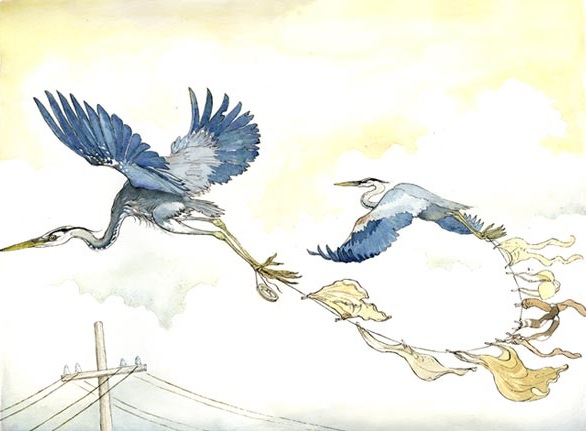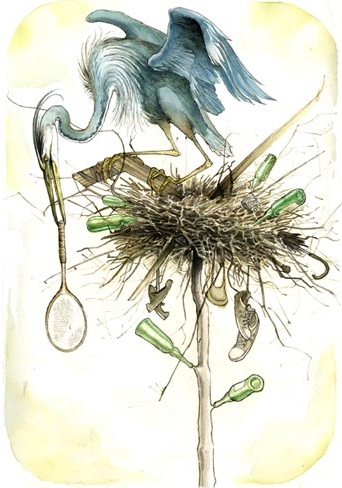The Blue Heron Apartments
Nesting habits on the edge of Stanley Park: a letter from Vancouver

A great blue heron flies right past me, so close I can hear its three-feet wings whooshing deep and slow. It’s a big bird, with hollow bones and a delicate gangliness: long, skinny legs; feet pointed like a ballerina; and a question-mark-shaped neck tucked into a greyish blue body. Its cerulean mullet of feathers flutters in the wind and its professorial eyebrows give the impression that the bird is assessing me as it flies south, toward the heronry.
I am observing this from the elev-enth floor of a Vancouver apartment building—part of a strip of brutalist concrete lozenge-shaped high-rises that divides the city from the wilderness of Stanley Park. Every spring for the past five years, the south end of the park has been overtaken by an increasing number of blue herons who’ve come from Vancouver Island and other parts of the Pacific Northwest. They come here to mate, building huge nests or renovating old ones in the trees beside the Parks Board office and the tennis courts. In 2004, at least 151 chicks were fledged from this heronry—from sixty nests in ten trees. This year, more than 200 chicks left 168 nests in twenty-five trees.
As humans, we’re always en-croaching on wildlife’s turf, wreaking havoc on the ecosystem; yet these herons have, bafflingly, chosen to move to the edge of the most densely populated city in Canada. Why would a reclusive species, sometimes known as “Big Cranky,” choose to live so close to us—so close that they can watch us in our natural habitat: smoking on our balconies, staring into the blue light of the television, playing air guitar, having sex? Are they as curious about us as we are about them?
Vancouver started tracking the heronry in the nineteen-twenties. In 1921, three nests were counted at Brockton Point, on the other side of Stanley Park. The herons nested there annually until the sixties, when they moved to the trees near the park’s former zoo, overlooking the depressed yellowish polar bears and angry monkeys. In 1994, the zoo was closed by public demand, but the herons stayed on and the population grew to forty-four nests. Then, in the spring of 2001, they suddenly showed up at this spot, across the street from prime West End apartments. If nothing else, these birds share our instinct for good real estate.
Like the blue herons, I come here every spring. I stay in this apartment for a month to look after my parents’ plants and to get away from city life. Though my own apartment is only six blocks away, it’s east of Denman Street. As any Vancouverite will tell you, everything west of Denman seems rabbit-hole fantastical compared to the rest of the city. Whole families of skunks and racoons roam the streets and bald eagles soar high above. Once I saw two baby otters playing at the shoreline of English Bay Beach. Another time, a coyote walked right past me, as though on its way to run errands on Denman.
My parents’ eleventh-floor apart-ment stands about level with the treetops. Being here feels like being in a remote cabin, save for some small reminders of human activity: a hot-air balloon advertising Bell drifts by; behind it, I can see the mountainside suburbs of North and West Vancouver, which look like awful scabs in the daylight but twinkle romantically at night; I hear the constant phump of tennis balls from the courts below and a band in the park playing “You Can’t Hurry Love” in anticipation of the 50,000 Sun Run joggers who’ll soon pass right under the heronry.
The herons themselves don’t seem bothered by any of this, and the her-onry bustles just like an airport, with birds arriving and departing every minute. They move gracefully through the trees and branches, even though their size makes it harder for them to ride wind pockets or make sharp turns. After mating, herons operate as a two-parent working family: one heron sits in the nest incubating the eggs or taking care of the chicks while the other hunts for sticks or food. The returning heron will call out a low frauuunk greeting as it approaches its home tree (one of the Stanley Park trees has been known to hold as many as twenty-six nests). The bird lands on a branch and then sidles carefully toward the nest to hand its mate the foraged food. Sometimes the herons face each other and raise their huge wings for a few seconds, and I’m not sure if they’re expressing affection or the stress of having to feed so many mouths.
 Herons hatch an average of four eggs a season, but only about 30 percent of chicks make it past the first year. If the food supply is insufficient, only the strongest nestlings will survive—the punier ones end up falling from the nest, pushed aside by their more dominant siblings, and parents will only feed the young who remain inside the nest. A month after the hatching, when the chicks can sustain a decent body temperature, the parents will both leave the nest to forage, leaving their kids alone. After two months, the young black-crowned birds know how to fly and head out to hunt alongside their parents.
Herons hatch an average of four eggs a season, but only about 30 percent of chicks make it past the first year. If the food supply is insufficient, only the strongest nestlings will survive—the punier ones end up falling from the nest, pushed aside by their more dominant siblings, and parents will only feed the young who remain inside the nest. A month after the hatching, when the chicks can sustain a decent body temperature, the parents will both leave the nest to forage, leaving their kids alone. After two months, the young black-crowned birds know how to fly and head out to hunt alongside their parents.
Though they’ll spend an entire summer bringing up the kids, blue herons don’t mate for life. By mid-October, they will abandon the heronry, disperse to other parts of the area, along the coast of the mainland or further away on Vancouver Island. The following spring, the herons typically return to their place of birth to breed, and the whole process will start anew with a different partner: the males will once again stretch out their long necks as the females go to the ground to signal that they’re ready to mate. When they meet, the birds cross bills, forming a heart shape with their beaks and curved necks.
Nobody really knows why the blue herons group together in heronries. Some theories indicate that it might be to safeguard the eggs and chicks against predators—in this case, Stanley Park’s eagles and raccoons.
The first time I heard the herons screeching in the trees, I thought someone was being attacked. It was in the spring of 2001, the herons’ first year in their new abode. Once I figured out that the birds were doing the screeching and that they weren’t in any real danger, I loved to lie in bed and listen to the pterodactyl-like frak-frak-ing. The herons also utter a chicken-like clucking noise and, when the colony’s chicks have hatched, the babies emit feverish tik-tikk sounds. Sometimes you can hear a “bill duel” or the sound of snapping branches as they thrash around. It feels like you live in a dense jungle full of giraffes, hippos, monkeys and snakes, and that you are somehow safe, up in your tree.
The herons’ selection of the current nesting site is an odd one,” according to the Stanley Park Heronry Monitoring Report. Even the annual summer fireworks festival “did not cause any herons to abandon their nests or chicks.” Some humans aren’t as smitten as I am with the herons and their screeching. A few locals have even registered noise complaints, though the report states that “the vast majority of residents and park users were intrigued, amazed and thankful for the experiences and memories generated by the heronry.”
If the herons were able to reminisce, like humans, I doubt they would have the time. The bird’s average life span is fifteen to twenty years. By the age of two, they’re building their own families; gathering food and avoiding predators are their main concerns. What would we be like if we lived accelerated lives? No long drawn-out childhood and adolescence. If you’re weak, your brother kills you off on day three. No complex decades spent trying to figure out who you are and what makes you happy—no months of getting to know yourself on a beach in Thailand. By the age of two, you’re already cruising bars for a good reproductive catch, which you have just twelve days to find. There are no years of moving from tiny studio to large apartment to house in the suburbs. You don’t acquire possessions; you don’t take photographs or organize the best ones in albums.
Really, though, most of us do the same things the herons do (some of us even return to the places we were born). We just take much longer to do them.





